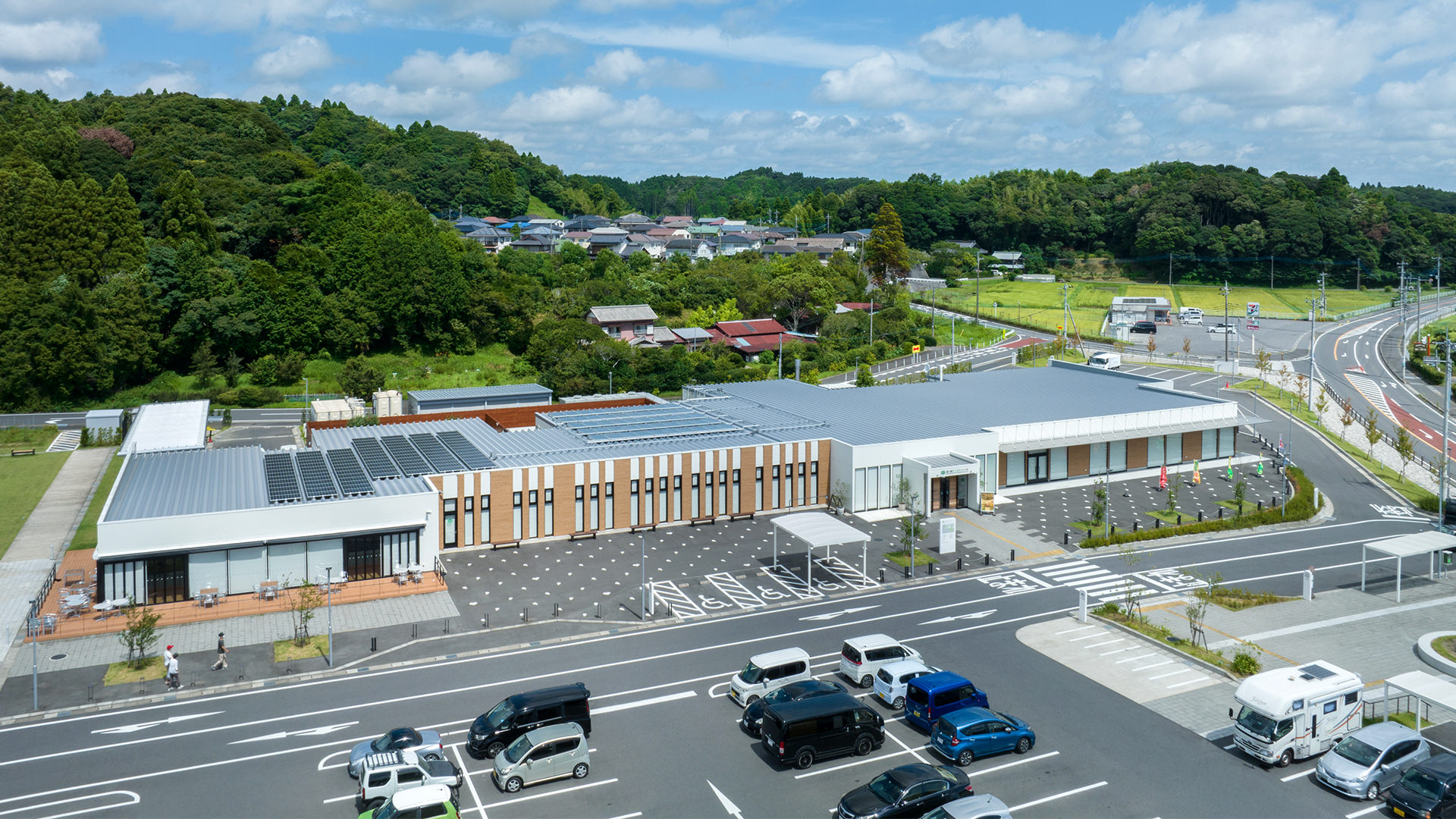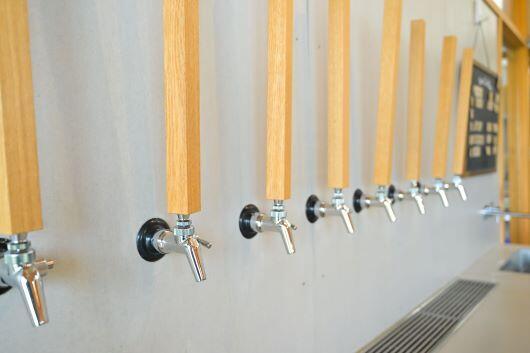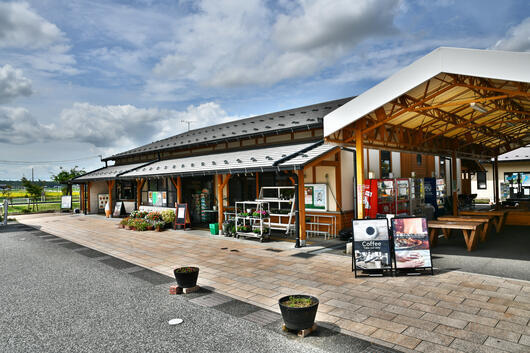"Roadside Stations", which began in 1993, are expected to have 1,230 registered stations as of the end of January 2025, and are expected to play a key role in revitalizing regional areas. However, while some are popular for selling goods, many are struggling with low user numbers. We interviewed about the current state of roadside station and their future direction to Ichiro MIYAMORI from the Infrastructure Business Management Dept., and Masaharu KATSURADA from the Project Promotion Sec. of Tohoku Social Innovation Business Dept. of Project Innovation Div. of PACIFIC CONSULTANTS which have been deeply involved in roadside station as a private business sector as well as providing consulting services to many local governments across the country, such as creating basic plans and conducting feasibility studies.
INDEX
- What is roadside station?
- Changes in the role of roadside station
- Disaster preventive functions of roadside station that drew attention after the earthquake
- Current status and issues of roadside station management
- Hopes are high, but challenges are also coming to light
- Strengthening PPP to operate roadside station
- Business method for roadside station management
- PACIFIC CONSULTANTS' initiatives to solve roadside station issues
- Clarifying the purpose of roadside station
What is roadside station?
Roadside station began to be established in 1993 with the aim of "Establishing roadside stations like railway stations as rest facilities for road users to help prevent accidents." Based on the "Rest function" of "Free parking available 24 hours a day, toilets, and a space for drivers to rest and gather road information," roadside stations are equipped with an "Information dissemination function" such as local tourist information, and a "Regional cooperation function" such as a regional development facility, and are facilities developed jointly by municipalities (or public organizations that replace them) and road administrators (national and prefectural governments). As of January 31, 2025, 1,230 stations have been established in 827 municipalities, which is about half of the municipalities in Japan. 678 stations (55%) are "Integrated" facilities developed jointly with road administrators along major roads with high traffic volumes, such as national highways, and 552 stations (45%) are "Standalone" facilities, with the proportion of "Integrated" facilities being high.
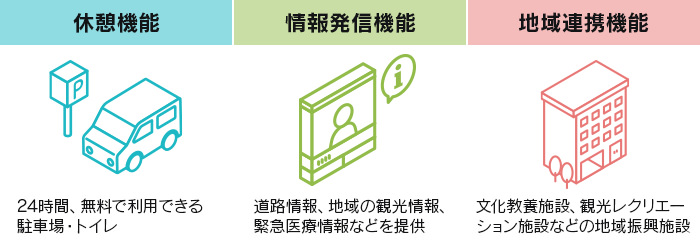
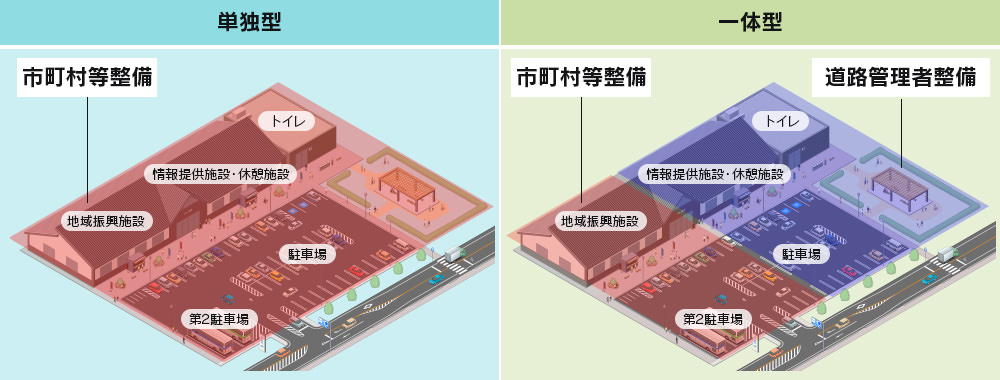
Source: "Roadside station Guide" (Ministry of Land, Infrastructure, Transport and Tourism)
Changes in the role of roadside station
Roadside station started out as places to provide rest for road users, but they gradually became popular for selling local specialty products, and thanks to various efforts by local governments, local people, and management operators, there are now more and more cases where roadside station themselves are chosen as destinations for tourists and travelers. The wide variety of roadside stations, some of which also have hot spring facilities and accommodation facilities, which is also one of the attractions for travelers.
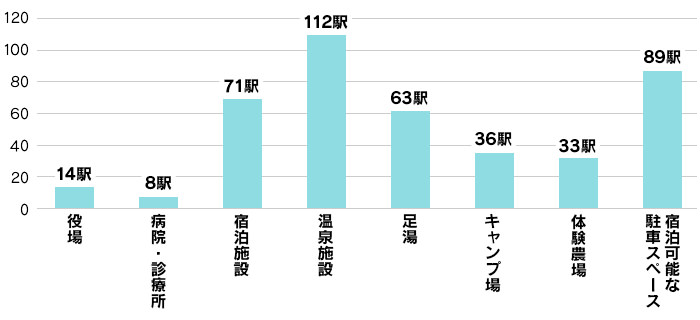
Disaster preventive functions of roadside station that drew attention after the earthquake
Having experienced the Niigata Chuetsu Earthquake in 2004 and the Great East Japan Earthquake in 2011, the function of roadside stations as regional disaster prevention centers has attracted attention, and some have begun to be included in regional disaster prevention plans. In 2021, Ministry of Land, Infrastructure, Transport and Tourism designated 39 roadside station in 36 prefectures across the country that meet certain requirements as "Disaster prevention roadside station." In Noto Peninsula Earthquake that occurred on New Year's Day in 2024, in addition to functioning as evacuation sites immediately after the disaster, they also played an active role as a gathering point for TEC-FORCE (Ministry Ministry of Land, Infrastructure, Transport and Tourism's emergency disaster response team), the self-defense forces, ambulance teams, infrastructure maintenance vehicles, and others during the recovery phase.
Current status and issues of roadside station management
Roadside station began as rest facilities for road users, but have since developed into tourist destinations and regional hubs in their own right. Today, they are positioned as hubs that spread the liveliness of roadside station, the horizontal collaboration between roadside station, and integrated initiatives between towns and roadside stations.
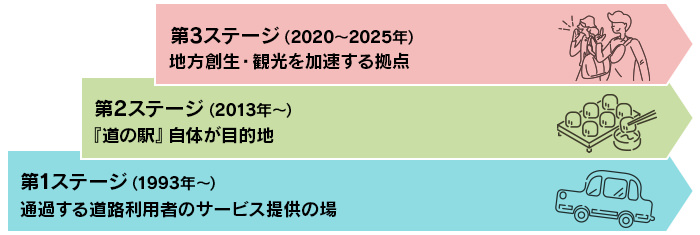
Hopes are high, but challenges are also coming to light
・Many roadside station are struggling with operating losses
However, while there are high hopes for the potential of roadside station revitalizing regional areas, various issues are also emerging to be solved. One of these is ensuring profitability. While there are popular roadside station that make over 1 billion yen a year and attract attention from all over the country, the reality is that there are many cases where roadside station with annual sales of less than 200 million yen are unable to cover management and operating costs from their sales and are operating at a loss. The reasons for establishing roadside station are different among local governments, and operating at a loss in itself cannot be said to be a problem in general, but since local governments have to bear the financial burden in various ways, such as through designated management fees, there are cases where this is viewed as a problem by local assemblies and other organizations.
・Lack of cooperation with the local community, not making full use of roadside station facility
In addition, although roadside station are bustling with visitors and are operating in the black, the number of visitors to roadside station tourist spots has not increased as originally intended, and it has become clear that only product suppliers to roadside station and restaurant and other businesses that set up shop at roadside station have reaped the economic benefits, with other local businesses not benefiting.
・Delays in responding to inbound tourism
Additionally, roadside station also aim to attract more inbound tourists. To achieve this, it is essential to provide multilingual support and introduce cashless payment, but many roadside stations have not yet implemented these features in details. Multilingual support is also an important element in responding to disasters, so there is a rush to develop it.
・BCP formulation is still limited to 3%
From the second stage onwards, the roadside stations are required to function as disaster prevention bases, but in the event of a disaster, they must first protect employees and visitors, and then fulfill their role as disaster prevention bases. BCP plans that are suited to the circumstances of each roadside station must be established, and employees must be made aware of them through education and training. However, while there are currently around 500 roadside stations included in regional disaster prevention plans, only 15 stations (3%) have formulated BCP plans. (Source: "Status of the 3rd stage of 'Roadside Station'" (Ministry of Land, Infrastructure, Transport and Tourism))
Strengthening PPP to operate roadside station
The environment surrounding roadside station is constantly changing, with a declining total population, an aging population, and a decrease in automobile traffic itself. In this environment, more than 30 years have passed since the system was launched in 1993, and the time has come to update and renew the facilities. When renovating or establishing a new roadside station, it is important to carefully consider the purpose and strategy of its establishment, taking into account the challenges that have been faced so far, and what role it will play in the development of the region. It is necessary to consider from the planning stage how roadside station will be operated and how it will be managed sustainably while contributing to regional revitalization. To this end, we believe that PPP that utilize the business concept and management capabilities of the private sector are an effective approach.
However, until now, 15.7% of roadside stations have been managed directly by municipalities, 31.1% by the third sectors, and 8.9% by foundations, etc., making up a total of 55.7%. Private companies such as designated managers only account for 44.3%, and the introduction of private sector vitality is still in the early stages. (Source: "About roadside station," September 2013. The breakdown is for 1,004 roadside stations at the time of the survey (Ministry of Land, Infrastructure, Transport and Tourism))
Business method for roadside station management
From the perspective of introducing private sector vitality, in addition to the designated manager system, which entrusts operation, it is necessary to consider the use of PFI and DBO, which also entrust maintenance. There is no superiority or inferiority in the business method itself. To what extent will the power of private business sectors be utilized? Will it be only operation, from the design of the facility, or will the fundraising itself be entrusted to them? It is necessary to select a business method that suits the purpose of establishing roadside stations.
| Main Systems | Overview |
|---|---|
|
Designated Manager System |
The management and operation of the facility is entrusted comprehensively to private business sectors, NPOs, and other organizations. It is expected that expertise and know-how will be demonstrated in management and operation. However, the designated management period is often around five years, making it difficult for operating business sectors to actively invest in the facility. In addition, when building a new facility, the designated manager is usually selected through a public bidding process after the facility's design and construction are ordered, making it difficult to reflect detailed management needs in the facility's development. |
|
PFI |
Based on the Act on PFI, this is a method in which private business sectors are tasked with the design, construction, and operation of public facilities, etc. by utilizing private funds and know-how. Funds raised by private business sectors (project financing) enable the monitoring function of financial institutions to function, and it is expected that the financial burden will be leveled out. |
|
DBO |
A method in which design, construction, and operation are all entrusted to private business sectors. Unlike PFI, it is implemented through a combination of contracting and outsourcing contracts, and the public sector provides the funds. As with PFI, it is expected that private know-how will be utilized in design, construction, and operation, taking into account the benefits of lump-sum ordering and long-term contracts. |
|
EOI |
Under this method, an operating business sector is publicly solicited and selected prior to the facility construction stage, and the facility is designed and constructed based on the wishes of the operating business sector. This allows preparations to proceed while reflecting the wishes of the operating business sector as much as possible in the construction phase. |
PACIFIC CONSULTANTS' initiatives to solve roadside station issues
PACIFIC CONSULTANTS provides support in various forms throughout the country, such as supporting local governments in everything from planning to deciding on business methods and other implementation measures, and supporting private business sectors involved in the management and operation of roadside station and promoting the management and operation work itself.
Approach as a roadside station operator
For example, we are the representative company of the "Mutsuzawa Tsudoi no Sato Roadside Station" in Mutsuzawa Town, Chiba Prefecture, which has a population of about 7,000, and we have formed an SPC with two local companies to operate it as a PFI project. Based on research results that show that opportunities to go outside and meet people contribute to improving health, we have positioned it as a core base for advanced preventive urban development, and we operate it as a "health support" roadside station equipped with hot spring facilities and a plaza, and joint research with the Chiba University Preventive Medical Center has shown that this is effective in improving subjective health.
This roadside station also has the goal of "Revitalizing the area by encouraging people to move and settle there," and as part of that goal, it has planned and operated a self-study classroom with supervision in roadside station's assembly room, providing a highly public service not available in the area. It also provides a place for local children to interact with children from Tokyo and experience nature, promoting the appeal of the area's natural surroundings and creating opportunities for people to move and settle there.
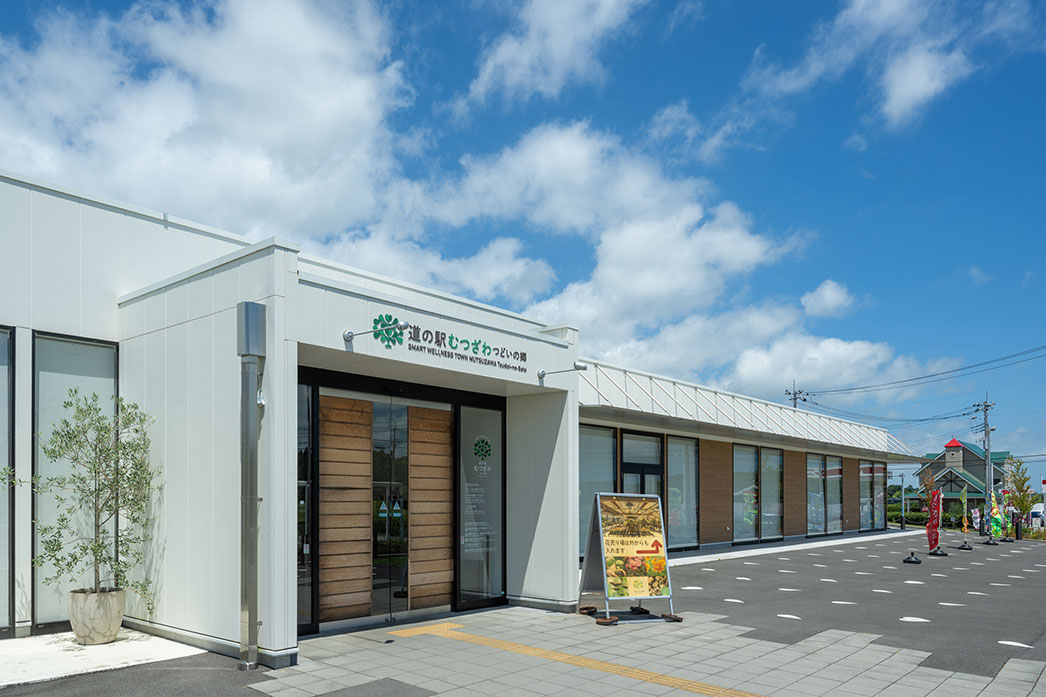
The town of Koura in Shiga Prefecture, with a population of approximately 6,500, operates "Seseragi no Sato Koura Roadside Station" as a designated manager. The roadside station under the concepts of "Let's build roadside station Koura together" and "Roadside station Koura traveling with dogs," the concept includes sales of local agricultural products at the direct sales counter, development and sales of original products, workshops for making furniture in collaboration with local residents, and interaction between visitors roadside station through the use of dogs. We are working to create a population that is not limited to the relationship of "Roadside Station = Service provider, Visitors = Service recipients," but rather, to create a population that interacts and has a relationship with as a starting point.
In addition, the "Koura Roadside Station" is working on initiatives that will promote the development of the entire region, not just roadside station, such as jointly developing processed foods with local business sectors, jointly developing and selling sightseeing tour products, and carrying out local tourism promotion activities.
<<Click here for our track record of joint research with local businesses>>
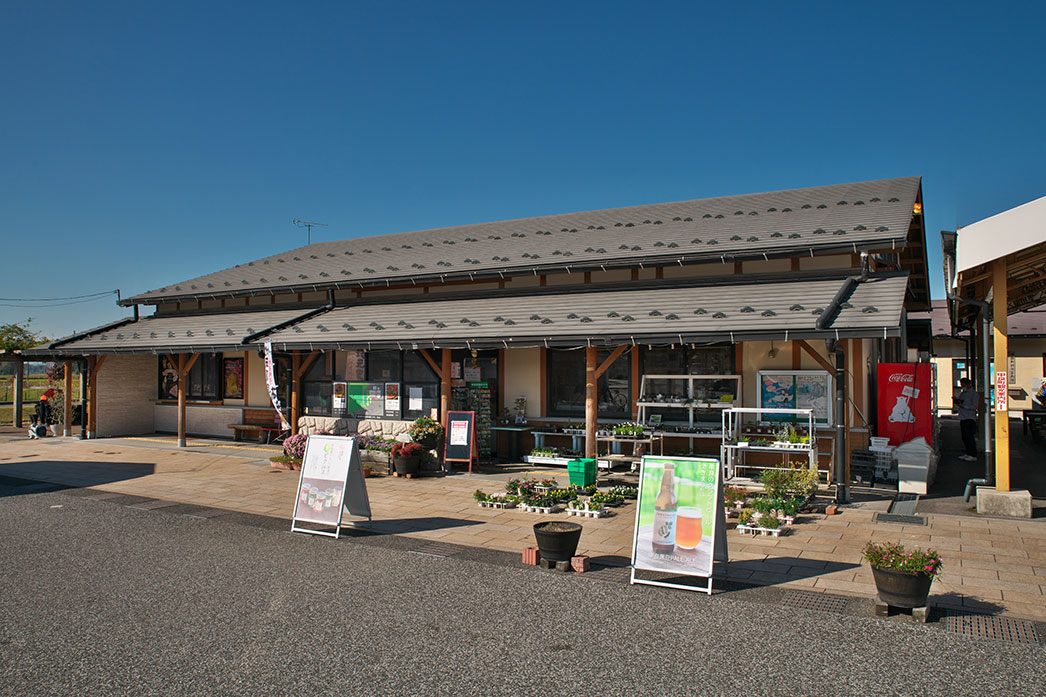
Approaches to support local government planning
PACIFIC CONSULTANTS is involved in the development of roadside station in various ways, from considering concepts, plans, and business methods for roadside station development in local governments all over Japan, from Hokkaido to Okinawa, to selecting operators and designing facilities.
As an example, roadside station development project in a region that is aiming to be certified as a UNESCO Global Geopark is based on the foundation of having the appeal and management capabilities to ensure that roadside station itself can make a solid income, and is also considering attracting tourists from overseas so that the effects of the project can spread to the region, and is working on foreign language support and planning tours that will please foreign tourists. In addition, a plan is being considered in which people can rent a camper for a few days, travel freely around the area, and spend time wherever they like. PACIFIC CONSULTANTS has been providing various support on the client's side from the planning stage, utilizing the knowledge gained from its approach as a roadside station operator, and is now in its fifth year of involvement since fiscal year 2021. It is expected to be completed in two more years.
Clarifying the purpose of roadside station
PACIFIC CONSULTANTS has a department that accompanies local governments in planning, developing, and managing roadside station, determines business methods and implementation methods from the planning stage, and supports the selection of operators and opening, a department that supports private business sectors companies that want to design, construct, and manage roadside station, and a department that participates in the management, design, and management of the entire project as a member of the business. By knowing the positions and realities of both the public and private sides in PPP for roadside station, we can reflect problems that tend to occur at the management and operation stage in the planning of local governments in advance, reflect concerns that PPP projects, and provide efficient and effective management and operation while taking into consideration the public interest that is the purpose of establishing roadside station.
We will continue to do our utmost to plan, develop, manage and operate roadside station which are expected to serve as a catalyst for regional revitalization.



